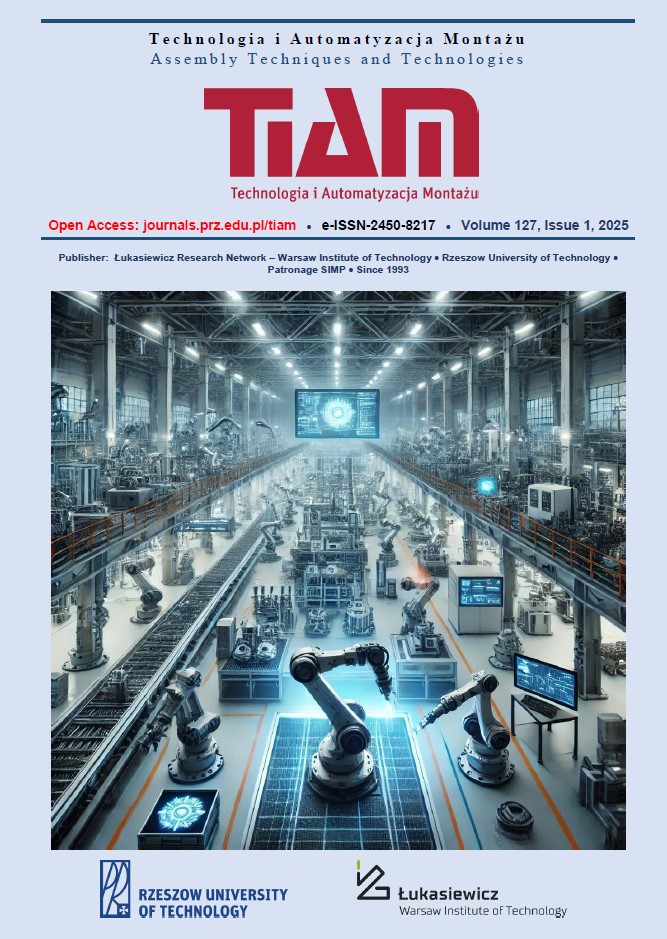Abstract
The authors present a research method and a prototype of a system for automatic accuracy control of manual measuring instrument readings. Most commonly used measuring instruments, such as dial indicators and bore gauges, require periodic accuracy control. The developed system is intended for control automation, minimising potential human errors connected with manual control and visual assessment of readings. The precise mechatronic actuators, measurement systems, and control software used in the system enable automatic execution of standard control procedures in accordance with the formal recommendations of the Central Office of Measures. The scientific and research results obtained will serve the development of methods for processing and analysing measurement data.
References
Arief Dodi Sofyan, et al. (2021) Calibration of Dial Indicator Using Calibration Tester with JIS B 7503 Standard. Journal of Ocean, Mechanical and Aerospace-science and engineering. 65.2, 82-87.
Chen T., et al. (2022). A novel robot calibration method with plane constraint based on dial indicator. arXiv preprint arXiv:2208. 02652, 1-7.
Eslami S., et al. (2016). In-bore prostate transperineal interventions with an MRI-guided parallel manipulator: system development and preliminary evaluation. The International Journal of Medical Robotics and Computer Assisted Surgery, 12, 199-213.
Gleeson, B. T. et al. (2010). Design of a fingertip-mounted tactile display with tangential skin displacement feedback. IEEE Transactions on Haptics, 3, 297-301.
Grimsmann F., et al. (2017), Hysteresis and current dependence of the thickness change of lithium-ion cells with graphite anode. Journal of Energy Storage, 12, 132-137.
Hemming Björn, at al. (2001). Calibration of dial indicators using machine vision. Measurement Science and Technology, 13.1, 45.
Iordache Iuliana, et al. (2010) High accuracy laser based machine vision for calibration of linear encoders and dial instruments. In: Advanced Topics in Optoelectronics, Microelectronics, and Nanotechnologies V. SPIE, 568-572.
Lui P. K. W., et al. (2015). Uncertainty evaluation of the calibration of dial indicator calibrators by laser interferometer. NCSLI Measure, 10, 20-23.
Macioski G., et al. (2024). Measuring Alkali-Silica Reaction Expansion in Concrete with Optical Fiber Sensors. In International Conference on Alkali-Aggregate Reaction in Concrete, 45-53. Cham: Springer Nature Switzerland.
Patent PL239823, (2021). Sposób ustawienia średnicówki dwupunktowej z czujnikiem zegarowym w urządzeniu do automatycznej kontroli dokładności wskazań.
Patent PL243868, (2023). Urządzenie do automatycznej kontroli dokładności czujników zegarowych.
Stancekova Dana, et al. (2015) Implementation of coating for failure elimination of dial gauges. In: METAL Conference Procedings of the 24th International Conference on Metallurgy and Materials. 1162-1169.
Wang H. M. (2011). A Kind of Automatic Verification Apparatus for Dial Indicator. Applied Mechanics and Materials, 44, 3589-3592.
Zarządzenie nr 50 Prezesa Głównego Urzędu Miar z dnia 18 kwietnia 1996 r. w sprawie wprowadzenia instrukcji sprawdzania średnicówek z czujnikiem zegarowym.
Zarządzenie nr 53 Prezesa Głównego Urzędu Miar z dnia 18 kwietnia 1996 r. w sprawie wprowadzenia instrukcji sprawdzania czujników zębatych zegarowych z działką elementarną o wartości 0,01 mm.
Zhong, L., et al. (2018). Dynamic accuracy evaluation for five-axis machine tools using S trajectory deviation based on R-test measurement. International Journal of Machine Tools and Manufacture, 125, 20-33.

